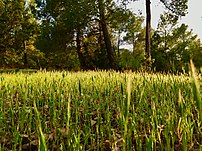
Image via Wikipedia
I received the following press release today from SMGF:
SALT LAKE CITY (Dec. 30, 2008)—Genetic research by the Sorenson Molecular Genealogy Foundation (SMGF) and scientists from ten organizations in Europe and the U.S. shows human groups with the deepest roots in southeastern Europe were not pushed out by an incoming wave of farmer-colonists as agriculture first spread into Europe. Instead, indigenous Europeans with a hunting and gathering lifestyle adopted agriculture when it was introduced by settlers from the Middle East. The study was published in the Dec. 24, 2008 online issue of European Journal of Human Genetics.
Scientists have long debated the question of how agriculture spread into Europe from its birthplace in the Fertile Crescent region of the Middle East. But the evidence—primarily archaeological—is inconclusive.
Applying molecular genetics to the question, an international team of researchers studied the Y-chromosomes, or paternally inherited DNA, of 1,200 men living in southeastern Europe where evidence of farming in Europe first occurs. If agriculture had spread there by Middle Eastern colonizers replacing an indigenous population, most of today’s southeastern Europeans should have Middle Eastern genetic roots.
But researchers found a large majority of southeastern European males are descended from genetic groups with roots in Europe that predate the change to an agricultural lifestyle. The strong inference is that farming spread culturally as local people adopted the technology.
Settlers from the Middle East were Europe’s first farmers. “Middle Eastern agriculturalists initially brought farming into southeastern Europe,†said Natalie Myres, study co-author and director of research and development for SMGF. “However, descendents of those first farmers do not dominate today’s gene pool. Most of the men in the study descend from people who lived in southeastern Europe well before the advent of farming.â€
Genetic scientists can test theories about ancient human history developed primarily by other disciplines by studying the DNA of people living today. Certain DNA markers found in today’s populations originated in ancient ancestors and have been passed through the generations essentially intact, and because DNA has a built-in molecular clock, scientists can estimate the timing and geography associated with our ancient ancestors’ movements.
This study found three major groups of interest. First, the European DNA groups, haplogroups I and R, make up about 60 percent of today’s population in southeastern Europe and represent some of the earliest modern humans to have occupied Europe, stretching back into Paleolithic times. Second, haplogroup E entered southern Europe from Africa’s eastern Sahara and became established in the region roughly 10,000 years ago. Third, haplogroup J is Middle Eastern and likely introduced agriculture into southeast Europe around 8,500 years ago.
Both of the two later-arriving lineages, haplogroups E and J each make up 20 percent or less of the region’s population. Lineages E and J are found predominately in the southern part of the Balkans, the region where Middle Eastern immigrants would have entered the area and where the first pottery associated with a farming society in the region is also observed. The study proposes that the haplogroup J lineage introduced farming to the inhabitants of the southern Balkans represented by haplogroup E. Members of haplogroup E subsequently transmitted the farming technology along the Adriatic where it was readily adopted by indigenous Europeans represented by haplogroup I.
“The central finding of this study is important because it illuminates our past, showing us how we became who we are today,†said Myres. “When these different ancient population groups met—Mesolithic foragers and Neolithic farmers—the outcome was productive and positive.†But Myres said the way agriculture spread to the rest of Europe can’t be generalized from this study since other regions in Europe appear to have followed a different model.
“We are gaining powerful insights into the deep history of the human family by correlating evidence from molecular genetics with research from other disciplines,†said Dr. Scott Woodward, executive director of SMGF and a prominent genetic researcher. “This study points the way for future investigations using the same methods in other regions.â€
Scientists for the study came from the University of Pavia, Italy; Stanford University; University of Tartu, Estonia; Universities of Sarajevo and Banja Luka, Bosnia and Herzegovina; Split and Osijek Universities and Genus doo, Croatia; Forensic Laboratory and Research Center, Slovenia; and University of Tetovo, the former Yugoslavia Republic of Macedonia. The study entitled, “Y-chromosomal Evidence of the Cultural Diffusion of Agriculture in Southeast Europe,†is now available online to subscribers at http://www.nature.com/ejhg/ and will be published in an upcoming print issue of European Journal of Human Genetics.
About Sorenson Molecular Genealogy Foundation
The Sorenson Molecular Genealogy Foundation (SMGF; www.smgf.org) is a non-profit research organization that has created the world’s largest repository of correlated genetic and genealogical information. The SMGF database currently contains information about more than seven million ancestors through linked DNA samples and pedigree charts from more than 170 countries, or approximately 90 percent of the nations of the world. The foundation’s purpose is to foster a greater sense of identity, connection and belonging among all people by showing how closely we are connected as members of a single human family. For more information about the foundation’s free, publicly available database, visit www.smgf.org.
Great blog, I really enjoyed this post. I will be back and have bookmarked your site. Thanks! Dana